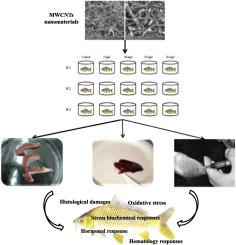Comparative Biochemistry and Physiology C: Toxicology & Pharmacology ( IF 3.9 ) Pub Date : 2020-06-24 , DOI: 10.1016/j.cbpc.2020.108832 Kamran Rezaei Tavabe 1 , Maryam Yavar 2 , Sara Kabir 2 , Paria Akbary 3 , Zahra Aminikhoei 4

|
Over the past decade, the usages of carbon nanotubes in various industries have been increased. Multi-walled carbon nanotubes (MWCNTs) are special form of carbon nanotubes which are used as nano-absorbents for various purposes of different industries due to their high surface to volume ratio. In aquatic environments these active nano-agents can easily absorb and accumulate in animal cells and tissues due to their tiny sizes and induce toxicity effects on bio-organisms mainly via pro-oxidants production. The present study assayed MWCNTs toxicity effects on anti-oxidative enzymes activities, serum hormonal and biochemical stress biomarkers, hematology parameters, histopathology and growth performance of the common carp Cyprinus carpio. Experiment was conducted in five treatments including 0 (control), 5, 10, 15, 20 mg/l MWCNTs in triplicate and each of the experimental tanks consisted of a 400-l recirculating system, stocked with, 20 fish (12 ± 2 g) for 28 days. The results indicated that by increasing the concentrations of the MWCNTs weight gain, specific growth rate and survival rate parameters were decreased. The findings showed that cortisol secretion, blood glucose level and anti-oxidative enzymes activities were increased with the increase of MWCNTs concentrations in the treatments. Histopathology results depicted that 15 and 20 mg/l MWCNTs caused hyperplasia, telangiectasia, apoptosis, and necrosis damages in gills and also, apoptosis, sinusoidal spaces, fibrosis, hepatocyte degeneration and necrosis in the liver of C. carpio. Despite these findings, further researches on effects of nanomaterials on aquatic organisms and ecosystems are essential to protect these environments against the newly found nanomaterials hazards.
中文翻译:

在实验室条件下,多壁碳纳米管(MWCNT)纳米材料对鲤鱼(Cyprinus carpio L. 1758)的毒性作用。
在过去的十年中,碳纳米管在各种行业中的使用有所增加。多壁碳纳米管(MWCNT)是碳纳米管的一种特殊形式,由于其高的表面积与体积比,可用于各种行业的各种用途的纳米吸收剂。在水生环境中,这些活性纳米剂的尺寸很小,因此很容易在动物细胞和组织中吸收和积累,并且主要通过促氧化剂的产生对生物产生毒性作用。本研究测定了MWCNTs对鲤鱼Cyprinus carpio的抗氧化酶活性,血清激素和生化应激生物标志物,血液学参数,组织病理学和生长性能的毒性作用。实验进行了五种处理,包括一式三份的0(对照),5、10、15、20 mg / l MWCNT,每个实验槽均由400升再循环系统组成,并装有20条鱼(12±2 g) ),持续28天。结果表明,通过增加MWCNTs重量增加的浓度,比生长速率和存活率参数降低。研究结果表明,随着处理中MWCNTs浓度的增加,皮质醇的分泌,血糖水平和抗氧化酶活性均增加。组织病理学结果显示15和20 mg / l MWCNT导致caused的增生,毛细血管扩张,细胞凋亡和坏死损害,还导致鲤鱼肝细胞凋亡,正弦空间,纤维化,肝细胞变性和坏死。。尽管有这些发现,对纳米材料对水生生物和生态系统影响的进一步研究对于保护这些环境免受新发现的纳米材料危害至关重要。



























 京公网安备 11010802027423号
京公网安备 11010802027423号